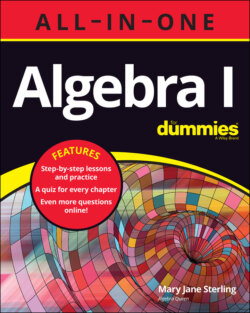Читать книгу Algebra I All-in-One For Dummies - Mary Jane Sterling, Mary Sterling Jane - Страница 30
Defining relationships
ОглавлениеAlgebra is all about relationships — not the he-loves-me-he-loves-me-not kind of relationship, but the relationships between numbers or among the terms of an expression. Although algebraic relationships can be just as complicated as romantic ones, you have a better chance of understanding an algebraic relationship. The symbols for the relationships are given here. The equations are found in Chapters 14 through 18, and inequalities are found in Chapter 19.
= means that the first value is equal to or the same as the value that follows.
≠ means that the first value is not equal to the value that follows.
≈ means that one value is approximately the same or about the same as the value that follows; this is used when rounding numbers.
≤ means that the first value is less than or equal to the value that follows.
< means that the first value is less than the value that follows.
≥ means that the first value is greater than or equal to the value that follows.
> means that the first value is greater than the value that follows.
Q. Write this expression using mathematical symbols: “When you square the sum of x and 4, the result is greater than or equal to 23.”
A. . The point of the inequality symbol always faces the smaller value.
Q. Write this expression using mathematical symbols: “The circumference, C, of a circle divided by the diameter, d, is equal to pi, which is about 3.1416.”
A. . The wavy equal sign means “approximately” or “about.”
Write the expression using the correct symbols.
19 When you multiply the difference between z and 3 by 9, the product is equal to 13.
20 Dividing 12 by x is approximately the cube of 4.
21 The sum of y and 6 is less than the product of x and –2.
22 The square of m is greater than or equal to the square root of n.
